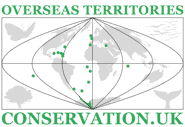
Falklands, South Georgia, Antarctica 2011
A visit to the Falklands, South Georgia and Antarctica
As many will know, a bus-man’s holiday is when one takes a vacation in the same subject area as one’s day-to-day activities. Ann and Mike Pienkowski chose to do this in November 2011, but in the markedly different geographical location of Antarctica and the far South Atlantic (first published in Forum News 39: 13-16).
We joined MV Plancius early in its second full Antarctic season, to visit the Falkland Islands, South Georgia and British Antarctic Territory. Oceanwide Expeditions has a long history of sustainable tourism by small expeditions in arctic and antarctic areas, and is one of UKOTCF’s corporate supporters. Some years ago, we had travelled on the MV Professor Molchanov, one of the 50-passenger Russian vessels which Oceanwide Expeditions used to charter. They replaced these with the 114-passenger Plancius, named after the Dutch astronomer, cartographer, geologist and vicar, Petrus Plancius (1552-1622). The 89m-long ship, then named Hr. Ms. Tydeman (no relative, as far as we know, to UKOTCF’s current Chairman), was an oceanographic research vessel of the Royal Dutch Navy from 1976 to 2004; she was purchased by Oceanwide in 2006 and completely refitted in 2009. Plancius’s smooth diesel-electric engines were a very clear change from the old days, with no detectable engine vibration or noise as we headed off from Ushuaia, at the southern tip of Argentina.
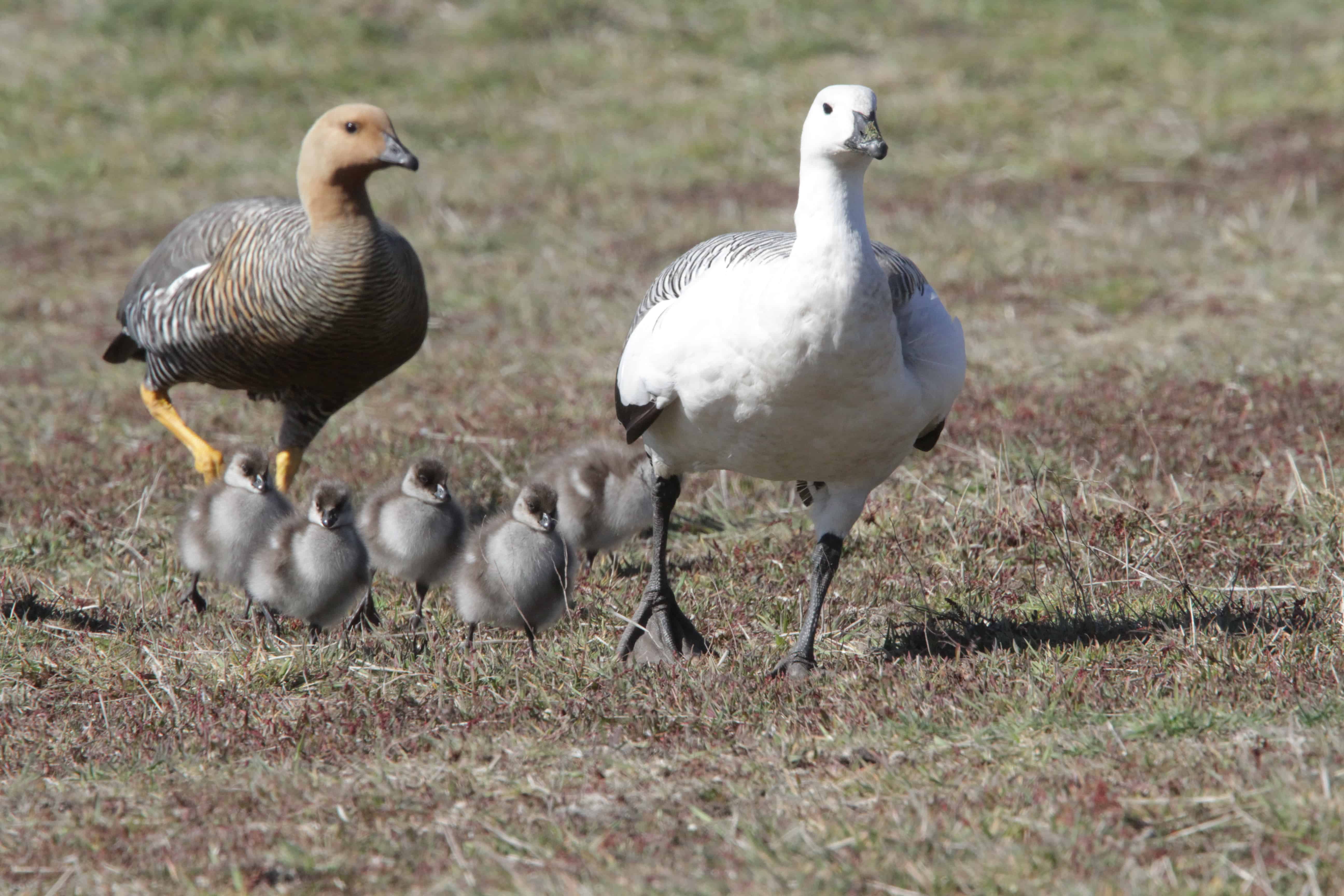
We were lucky with the weather for the 11⁄2 days as we headed north-east for the Falkland Islands, with much time spent out on deck, watching the many seabirds, especially the flocks of lovely cape petrels which we were rarely without throughout the voyage, as well as the huge giant petrels and the black-browed albatrosses. The excellent conditions also undoubtedly helped us get our sea-legs. After taking anti-sea-sickness pills for the first few days (and having enough in reserve for the entire trip!), we stopped taking these after 2 days and did not suffer from sea-sickness during the rest of the voyage – despite some impressive weather later. A recognised – and effective – way of avoiding sea-sickness is to keep eating. This has a great advantage when the meals are as good as they were on Plancius, but the disadvantage that remedial action is required after the trip to fit into one’s clothing.
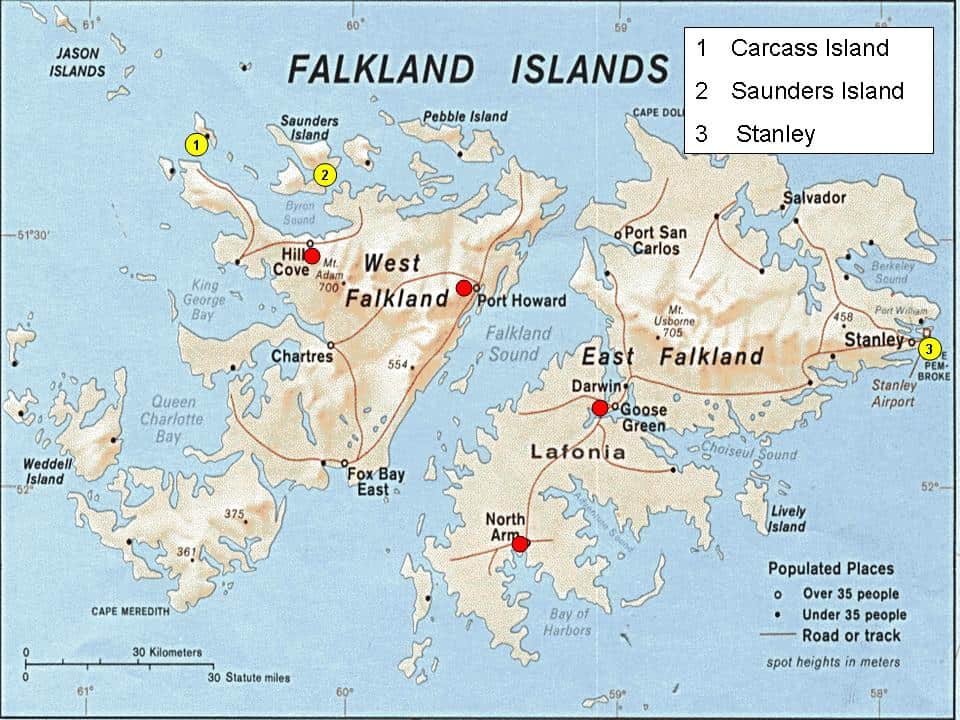
We were delighted to discover that one of the guide/lecturers was Ali Liddle from the Falkland Islands and UK, with whom Ann had worked previously on environmental education matters in the UKOTs. Other members of the team included a French team-leader, a British deputy, a Canadian whale expert, a British geologist, an Irish bird-man, and a Pole who led expeditions repeating the efforts of the early explorers. The Russian captain had great Arctic/Antarctic experience and was supported by Dutch officers and a crew mainly from Russia and the Philippines. The excellent international accommodation/catering team was led by an American-resident Brit, supported by a deputy from Austria (coping rather well in a ship that moved rather more energetically than his previous Danube river boats) and a head chef from Germany. Passengers were from, amongst elsewhere, UK, Netherlands, Switzerland, other European countries, USA, Australia, New Zealand, Venezuela, and a group from Taiwan, with a young interpreter who did an excellent job, most announcements and presentations being in English, but with translation into German for the substantial numbers whose language that was.
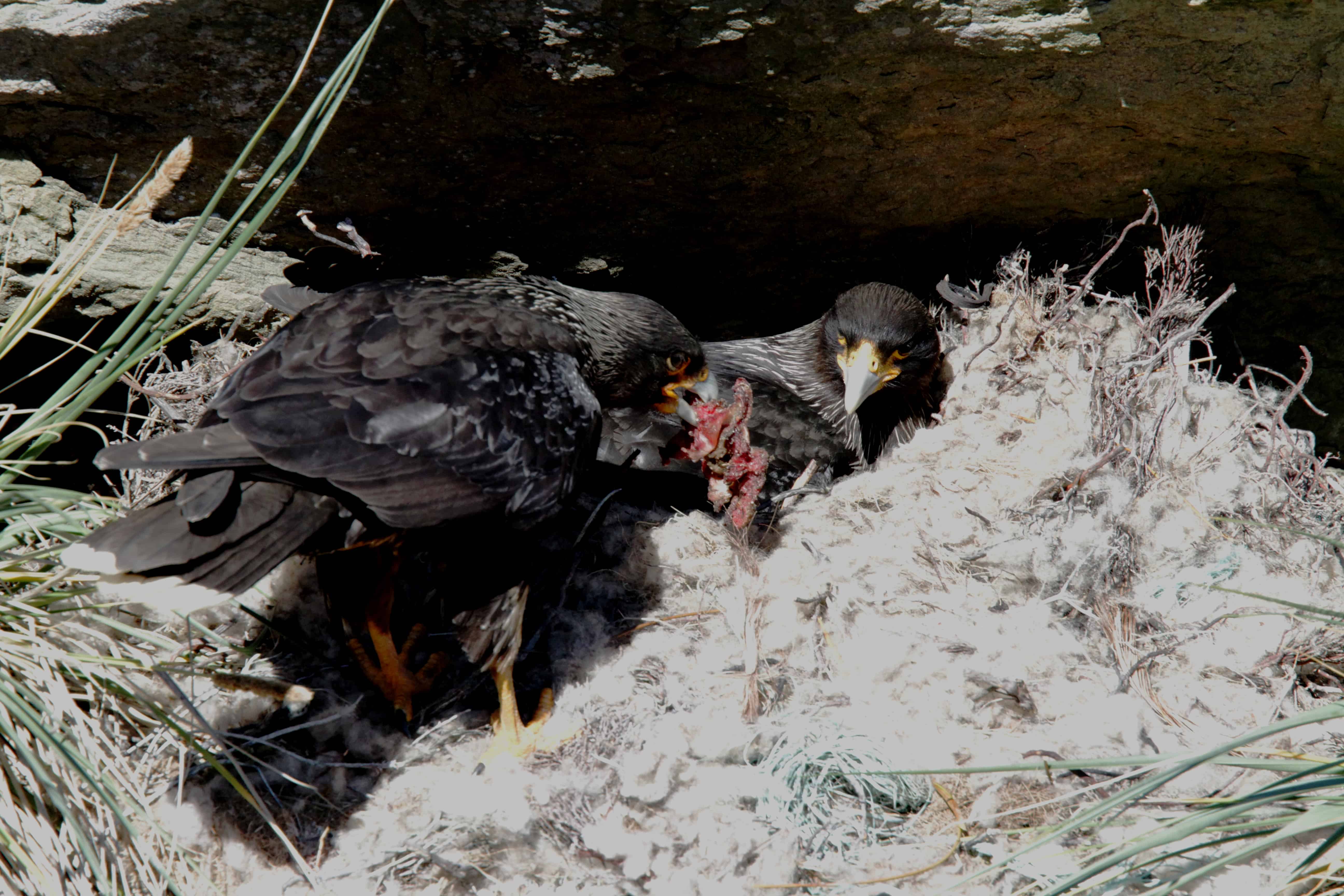
We awoke very early on 3rd November to seabirds milling about the ship as we passed through the Woolly Gut between West Point Island and West Falkland mainland. Landings by Zodiac rigid inflatable boats were made that morning and afternoon at Carcass and Saunders Islands. At the former, those undertaking a 5-km walk were rewarded with sights of a pair of Magellanic oystercatchers brooding chicks, tussock birds searching the drying kelp on the beach for amphipods and insects, Falkland Islands flightless steamer ducks, turkey vultures, colonies of Magellanic and gentoo penguins, meadowlarks, austral thrushes, upland, ruddy-headed and kelp geese, crested ducks, and striated caracaras on nests, amongst much other wildlife – followed by a traditional offering of tea and a mountain of cakes and biscuits at the settlement. (Good to see these British traditions being maintained, by the excellent Chilean staff!) A walk from the afternoon landing at The Neck on Saunders Island took us to the largest gentoo penguin colony in the Falklands, with 12,000 pairs spread over many sub-colonies, mainly on the crests of small hills. A small colony of king penguins had one well-grown chick, and Magellanic and a macaroni penguin were also present. Up the hill took us to nesting blue-eyed shags, rockhopper penguins and black-browed albatrosses – all in warm sunshine.

The following morning found us approaching Stanley, where we took a day off from vacation, having arranged meetings with people based in Stanley. We were able to catch up on a range of issues with His Excellency Nigel Haywood, Governor of the Falkland Islands and Commissioner of South Georgia and the South Sandwich Islands (as well as M.Sc. in butterfly conservation!). At Government House, we dropped in on the Government of SGSSI and had discussions with Darren Christie, about to move from Environmental Officer there to join Falkland Islands Government in a public information role. Current work on dealing with invasive species, international environmental conventions, research needs and conservation collaboration were some of the matters addressed. Later, we met Nick Rendall, a Falkland Islander who had been FI Government Environmental Officer for some two years. As well as putting faces to each other, having previously communicated remotely, we were able to discuss such matters as the biodiversity strategy, Ramsar Sites, marine conservation, invasive species and future cooperation. Finally, we were able to visit Falklands Conservation at Jubilee Villas to meet and discuss a range of matters with their new Director, Dr James Fenton.
Back on holiday, we headed SE towards South Georgia, 21⁄2 – 3 days away. The winds and seas remained light but clear skies (with good bird watching) alternated frequently with thick fog banks. As we crossed the Antarctic Convergence, new species such as blue petrel appeared, as well as a rare sighting of strap-toothed whales. A break from sea-watching was taken for the mandatory vacuuming of all our outer gear ready for landing in South Georgia. The government of South Georgia is very conscious of the threat of invasive species in the form of plants and seeds, and quite rightly insists that international travellers vacuum their kit to remove any seeds which may drop out and germinate. Walking through disinfectant buckets before and after landings was a feature throughout the Antarctic.
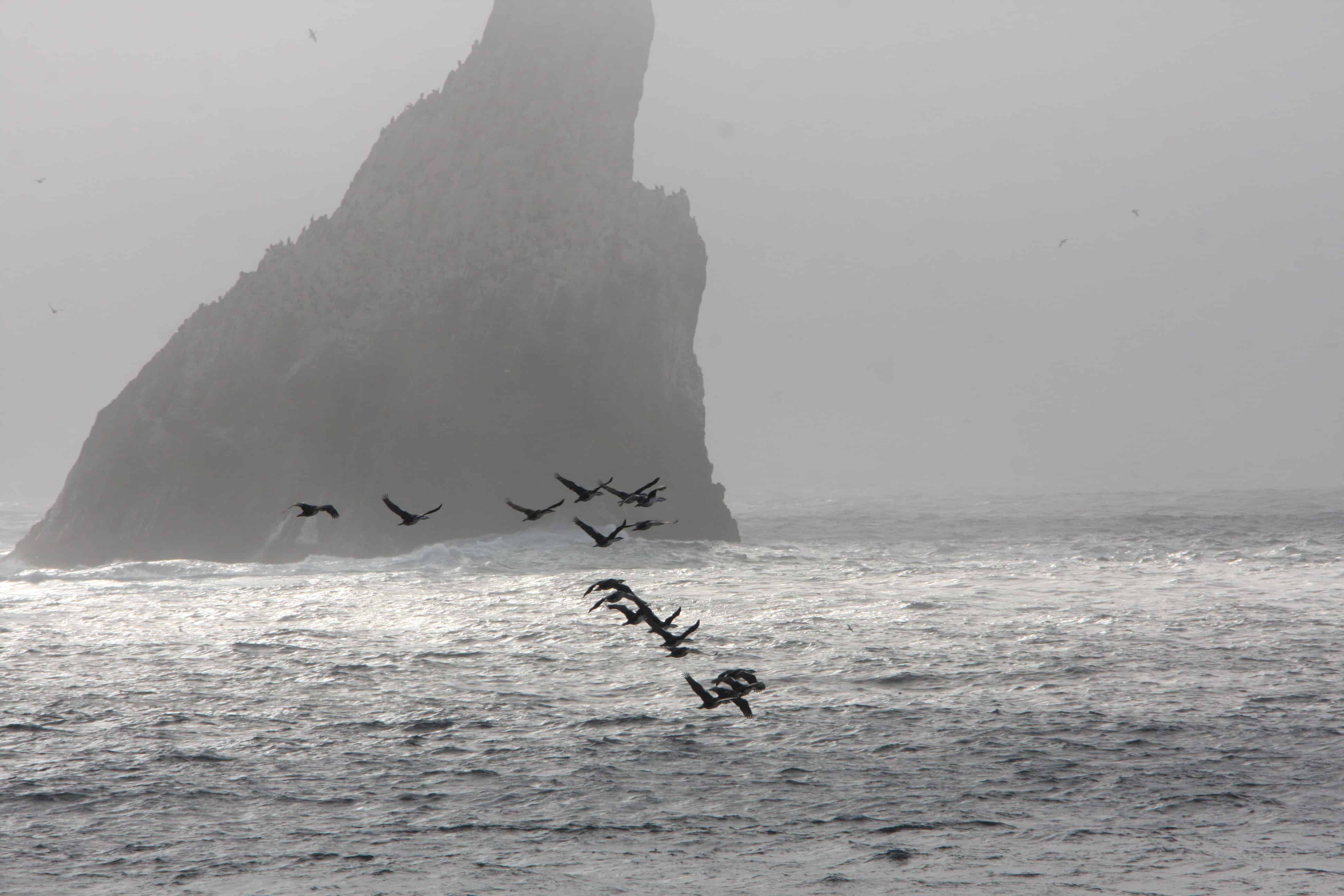
A return to fog banks gave superbly atmospheric conditions as we approached the outlying Shag Rocks (240 km W of the main island of South Georgia and about 1000 km from the Falkland Islands) on the evening of 6th November. The main entertainment began with humpbacked whales and with assorted seabirds, climaxing with large flocks of South Georgia shags flying close past the ship to roosting and nesting sites on the Rocks.
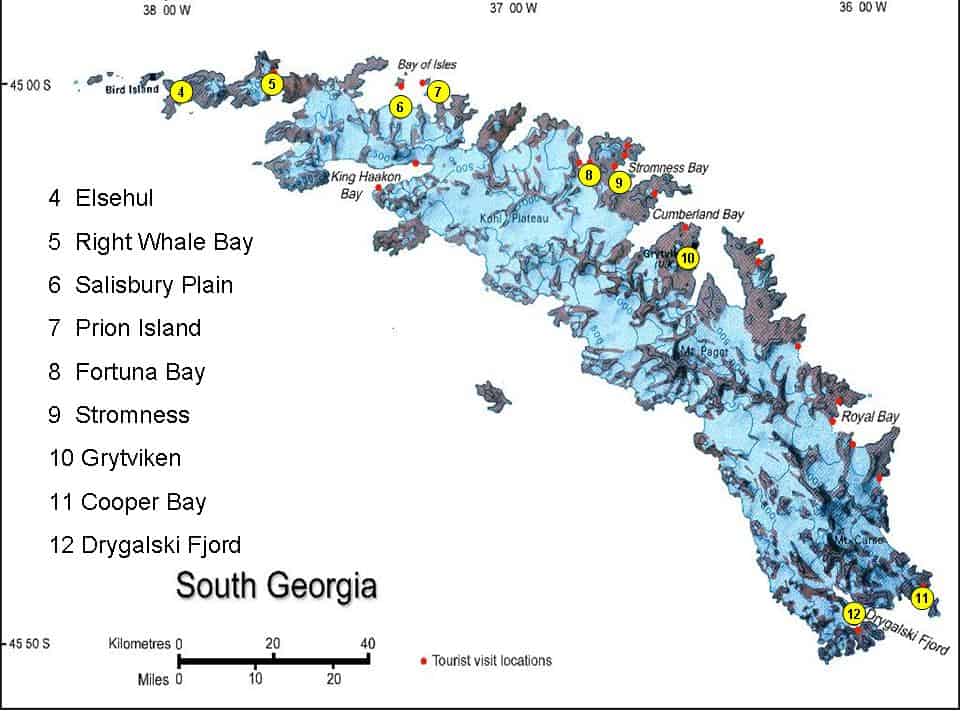
The following morning found us at Elsehul, near the NW tip of the main island. We spent four days working our way along the north-eastern side of South Georgia, usually landing at two locations per day. At Elsehul, we had superb views of nesting light-mantled sooty and grey-headed albatrosses, as well as fur seals establishing their territories among the rocks and tussac grass, elephant seals, giant petrels, skuas, and macaroni penguins emerging from the sea and scrambling over the slippery kelp-covered rocks. That afternoon, we landed at Right Whale Bay, with large elephant seal harems and king penguin colony, with large creches of the “woolly” chicks.

The following day took us to the Bay of Isles, with a morning landing at Salisbury Plain. Jostling for space on the beach were thousands of king penguins, fur seals, elephant seals and giant petrels. At the king penguin colony (estimated 60,000 pairs), thousands of whistling chicks and trumpeting adults crowded together, with chicks begging food and adults occasionally providing a meal of partially digested fish. The parents recognise their offspring by their calls and ignore the attempts by other chicks to stimulate a feeding response.
In the afternoon, we crossed the Bay to Prion Island. To keep numbers on the island at a non-disturbing level, different parties visited at varying times, staggered in time with zodiac cruises. Since we last visited this island, a wooden walkway has been built from the shore up the hill to the albratross and giant petrel nesting areas. Although controversial at the time, we feel that this is sensible, not just to make the walk up the peaty gully easier, but also to reduce erosion, and manage the areas of access. Despite deteriorating weather into drizzle and reduced visibility, good views were had of almost fully grown wandering albatross chicks, as well as giant petrels, brown skuas, South Georgia pintail ducks resting on the boardwalk and, particularly well seen among the shore rocks from the zodiacs, South Georgia pipits. This endemic species is the world’s most southerly songbird. It is abundant on Prion Island due to the absence of rats, of benefit also to other birds.

A landing the following morning at Stromness, once a bustling hive of industry with the busiest ship-repair yard in the southern hemisphere but now a dilapidated ruin. In case of flying debris and air-borne asbestos, approach closer than 200m is forbidden. A walk up the valley gave good views of nesting Antarctic terns and of reindeer. The latter were introduced a century ago, as a source of food for the whalers. Although attractive, they are in the wrong place and have severely damaged the natural vegetation. Fortunately, after a wide public consultation, the Government of SGSSI has decided to remove the reindeer, and is investigating the best methods.
Our afternoon landing at Grytviken provided a closer look at an old whaling station, as well as the traditional drink to the memory of Sir Ernest Shackleton at his memorial in the cemetery – and excellent views of pintails and other wildlife nearby. The museum provided an insight into the hard working life and ingenious social life of the whaling men, as well as the natural environment. We took the opportunity also for chats with SGSSI Government Officer, Pat Lurcock, as well as his wife, Sarah, who is the local representative of the South Georgia Heritage Trust, which is conducting the current rat-eradication project (see Forum News 36: 8). That evening, these and their colleagues from the Trust and staff from the British Antarctic Survey station at King Edward Point joined the ship for a barbeque dinner.
Our final morning at South Georgia started at the south-eastern tip, Cooper Bay, where chinstrap penguins, a new species for the trip, joined gentoos and macaronis. A landing and climb which took some of us to a macaroni colony amongst the tussac, was followed by a zodiac cruise. At the main beach, where there were a number of large elephant seal harems with ‘beachmasters’ bellowing their dominance over the bay, king penguins could be seen carefully walking between these huge seals to reach their small colony at the back of the beach. From here we went around the headland to a beach of chinstraps, and superb rafts of cape petrels on the sea.
Our South Georgia visit ended with a ship’s cruise up the 14-km-long Drygalski Fjord. Its sheer sides are the oldest rocks in South Georgia, hard granite remnants of the super-continent of Gondwana. Great views of the hanging glaciers also gave clear signs of the retreat of these due to global warming.

The weather began to change markedly, and we were grateful for how lucky we had been so far. Satellite information revealed that the sea-ice was still thick around the South Orkney Islands so that, rather than trying to call briefly there, we took a more northerly route towards the South Shetland Islands, towards Elephant Island, at the eastern end of that chain. In doing this, we were effectively doing Shackleton’s famous emergency boat-trip in reverse. As if in tribute to the weather conditions he endured, the wind increased to storm. A visit to the bridge to look at the weather forecast maps obtained over the internet showed a whole series of storms approaching us over several forthcoming days through the Drake Passage. Emailed messages from ships already at the Antarctic Peninsula indicated most landings as unusable due to late ice. Not looking good!
With three sea days ahead of us in the Scotia Sea, it was time for some wildlife watching, including numerous fin whales, before the sea became too rough – or, for some, downloading and sorting photos, catching up on reading, or sleep. With winds at storm force and waves reaching 10m, on the second day of this rough ride, Mike found himself lecturing on UKOT/CD conservation and UKOTCF to the passengers and some crew – in fact, a remarkably full room despite the conditions. It was the first time that he had lectured while clinging with one arm to a pillar.

Three days after leaving South Georgia, Clarence Island was spotted, indistinct and away to our port side, followed by the 240m tower of Cornwallis Island to starboard, and then Elephant Island, lit by shafts of hazy sunlight. This was home to the men of Shackleton’s Endurance expedition for 41⁄2 months, after shipwreck, haul over ice and a long boat trip. They lived under upturned boats on a diet of penguins while ‘The Boss’ and a few companions went by small boat to South Georgia for help. Having just crossed the same seas in a modern ship, we were even more impressed by their achievements in 1916.
We woke very early the next day, 14th November, to a calm sea with large icebergs and birds – and, grabbing clothes and cameras, dashed out on deck. We were in the Antarctic Sound, the first opening between the Drake Passage/Bransfeld Strait and the Weddell Sea. Slightly to everyone’s surprise, as we entered the Weddell Sea, the ship was able to find a way through the ice to Paulet Island, so that we may have been the first ship to land there this season – and under spring sunshine and blue sky. Paulet Island is home to nearly 100,000 breeding pairs of Adélie penguins and, even before we had put the zodiacs in the water, we could see, hear and smell the birds in the colony. Our landing was a little delayed as an iceberg headed straight towards the ship and got caught up in the anchor chain making both the anchorage and the gangway to the zodiacs unsafe. After some careful winching of the chain we were able to relocate. All along the shore, Adélie penguins were busily going about their business travelling from the sea to the colony, where birds were incubating their eggs in shallow nests of pebbles – the latter the objects of much stealing, transporting in beaks and careful positioning. There were many shags flying with nest building materials, sheathbills, and Weddell seals, including one young seal with its mother.

We then sailed carefully back through ice, which had moved position since our arrival a few hours earlier, past postcard-perfect mountain scenery and icebergs. By late afternoon we were back at Antarctic Sound and anchored off the impressive rock escarpment of Brown Bluff, a 750m rust-coloured cliff which overlooks the penguin colony below and from which the Antarctic continent stretches south to the pole. We landed on the Antarctic continent and viewed the small colonies of gentoo penguins scattered along the length of the beach leading to the main Adélie penguin colony at the far end from the landing site. Cape petrels could be heard chattering on their nests high up on the cliffs and Wilson’s storm petrels were making their way back to their rocky burrows after a day spent feeding at sea.
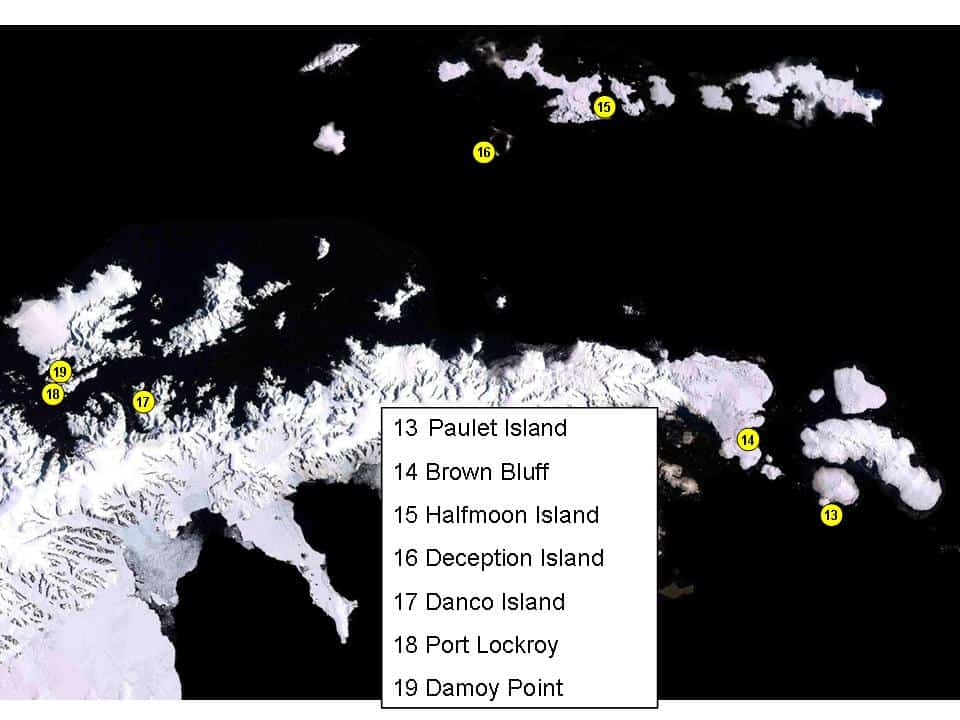
Travelling overnight across Bransfeld Strait to the western South Shetland Islands, we approached Half Moon Island early in the morning of the 15th, a light snow fell on a wind-free sea. The entire island was snow-covered. We walked past several Weddell Seals, one of which was working through its incredible repertoire of sounds; this species is the most vocal of seals. We reached a superb colony of chinstrap penguins, establishing their nest-site territories and mating at the start of the breeding season, as snow cleared from patches of rock. We were amazed at these birds walking hundreds of metres up steep snow-covered slopes carrying rocks from the shore to make their nests.

About five hours of sailing took us to Neptune’s Bellows, which is the spectacular entrance to the hidden flooded caldera of Deception Island. It is a very narrow passage made even narrower by a dangerous submerged rock pinnacle that has scraped the bottom of more than one unwary ship over the years. The island is about 15 km in diameter, and the inside is large enough to have had an airstrip when the British established a base during the Second World War. This, and the bases of Argentina and Chile, were abandoned when the sea inside the caldera started boiling in an eruption in the 1960s. Steam was rising from the water, which was a little warmer than freezing and had a distinct odour of sulphur. However, we did not join those of our fellow passengers who decided to swim. The ship’s doctor and a zodiac were on stand-by to whisk them back to the ship. Our faithful companions, the cape petrels were feeding actively right at the water’s edge, and nesting on the cliffs above. A kelp gull repeatedly plunge-dived to catch starfish. Skuas rested and bathed in a fresh-water pool. Weddell seals slept on the shore. Gentoo penguins bathed in the sea. The remnants of the whaling station and the British base, including the hangar were visible. A remarkable and peaceful place – at least at present.
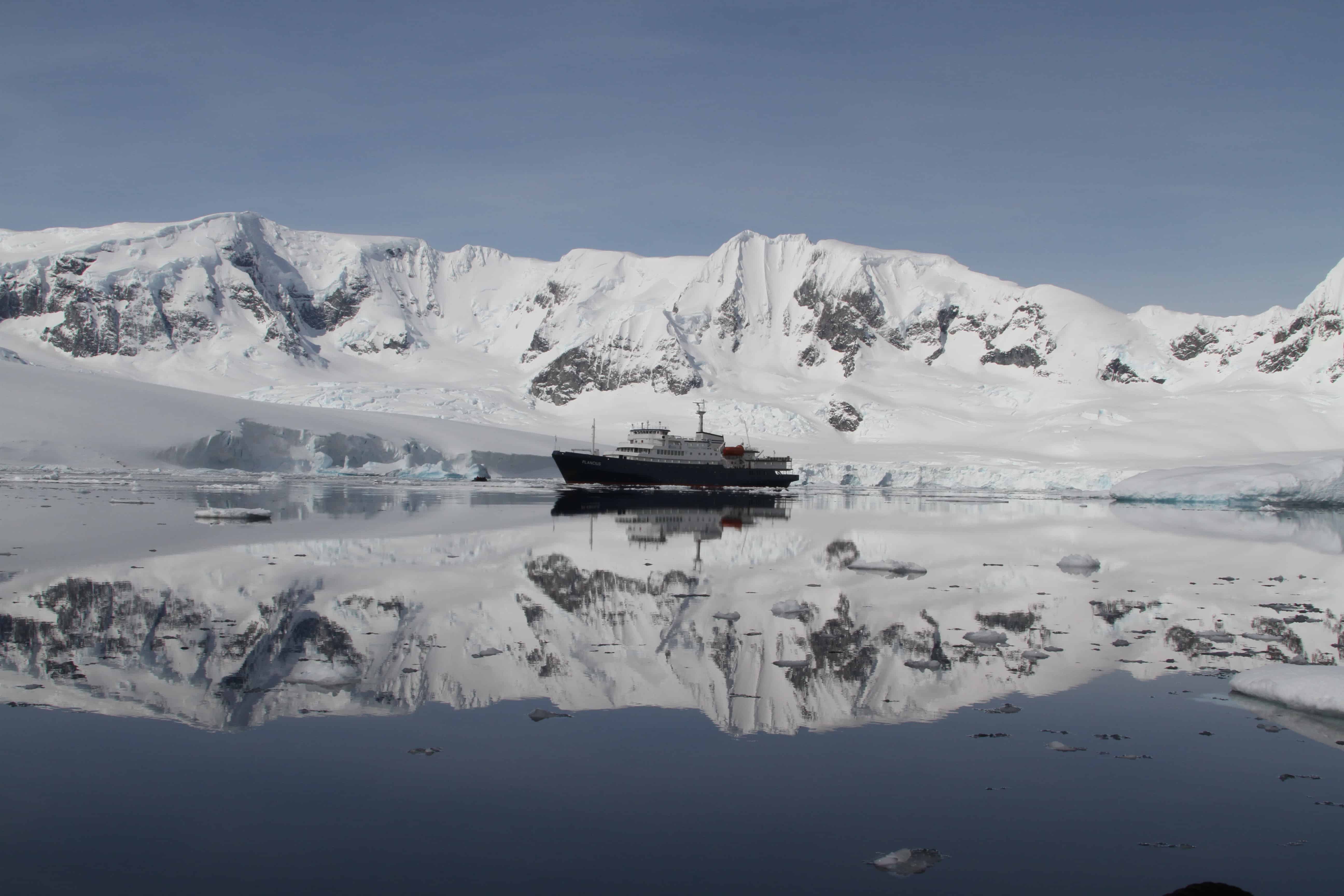
The following morning was magical. At 06:00, the ship was working its way south in the Gerlache Strait, between the west coast of the Peninsula and large offshore islands, in a startlingly beautiful land- and sea-scape. A pod of rarely seen Arnoux’s beaked whales briefly came near to the ship before diving under it. Following breakfast, Plancius was carefully manoeuvred through much ice to stop (without anchoring to avoid floes snagging the chain) in the Errera Channel, near Danco Island. One of the great advantages of this ship is that it has enough zodiacs to carry all the passengers at the same time. At 09.00, all ten zodiacs set off for a two-hour cruise. Crab-eater seals, gentoo penguins porpoising and leaping out of the water to their colonies, snow petrels and sheathbills on and over ice, ice-bergs, perfect reflections of towering mountains, an avalanche, sparkling sun on blue ice; it all added up to the most perfect morning imaginable.
A ship’s cruise through narrow channels finally led us through Neumayer Channel to Port Lockroy, another of the British bases established in the Second World War. We visited the historic base with its shop and post office, and took a short walk on neighbouring Jougla Island amidst the gentoo penguins and Antarctic shags. The three Lockroy ladies along with Michael, the carpenter, joined us back on board for dinner (and a late zodiac trip back for them with ice forming on the sea). We bid farewell to Rachel Morgan, Executive Director of the UK Antarctic Heritage Trust, who was joining her team. We had enjoyed many discussions on board with Rachel, and are very pleased that UKAHT has since joined UKOTCF as an Associate (see p. 12 of Forum News 39).
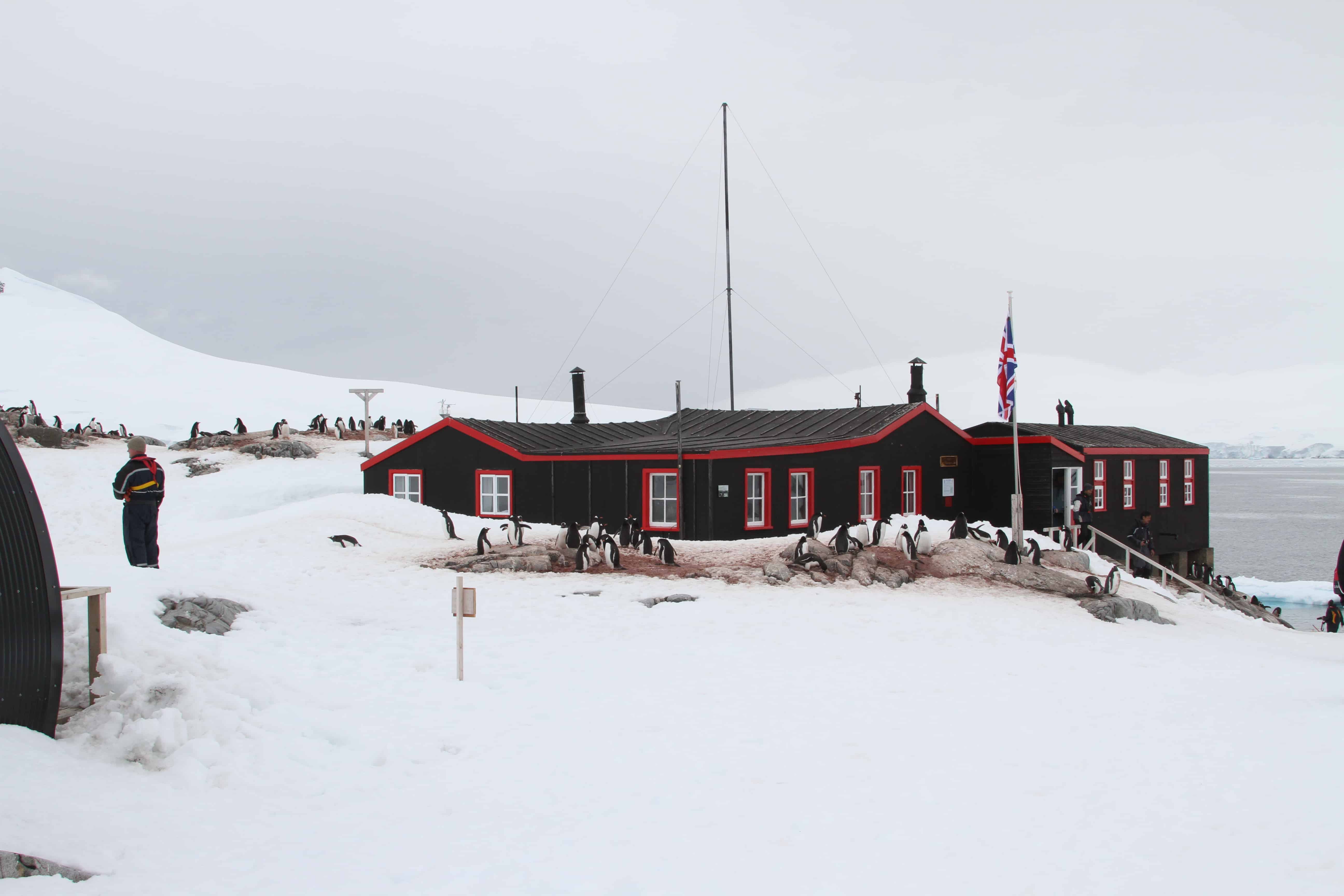
After anchoring overnight, a very early start was rewarded with fine weather and a zodiac ride through the ice to nearby Damoy. Here, we fitted snowshoes to walk to the old hut and around the gentoo colonies. This cabin was used from 1975-1990 by the British Antarctic Survey as a transit station. Often, ice would prevent the supplies and scientists from getting south to their research stations until late in the season. Therefore at Damoy, people and luggage would be transferred to planes for onward journeys south. These aircraft, normally De Havilland Twin-Otters, would be ski-equipped for a rather exciting landing on the glacial ridge behind the cabin.
We returned to the ship for breakfast as the Captain began to steer us towards the Drake Passage. Several of us had hoped that we would use the Gerlache Strait route in the hope of more wildlife sightings. However, we headed off towards the open sea around the south of Anvers Island, only to make a 180 degree turn as that route was blocked by ice. Therefore, we enjoyed an extra ship cruise, after all, back through the sunny Neumayer Channel and Gerlache Strait. Ann spotted the Arnoux’s beaked whales again in the distance, but they headed off rapidly – possibly because of the two killer whales (orcas) which we sighted a few minutes later.
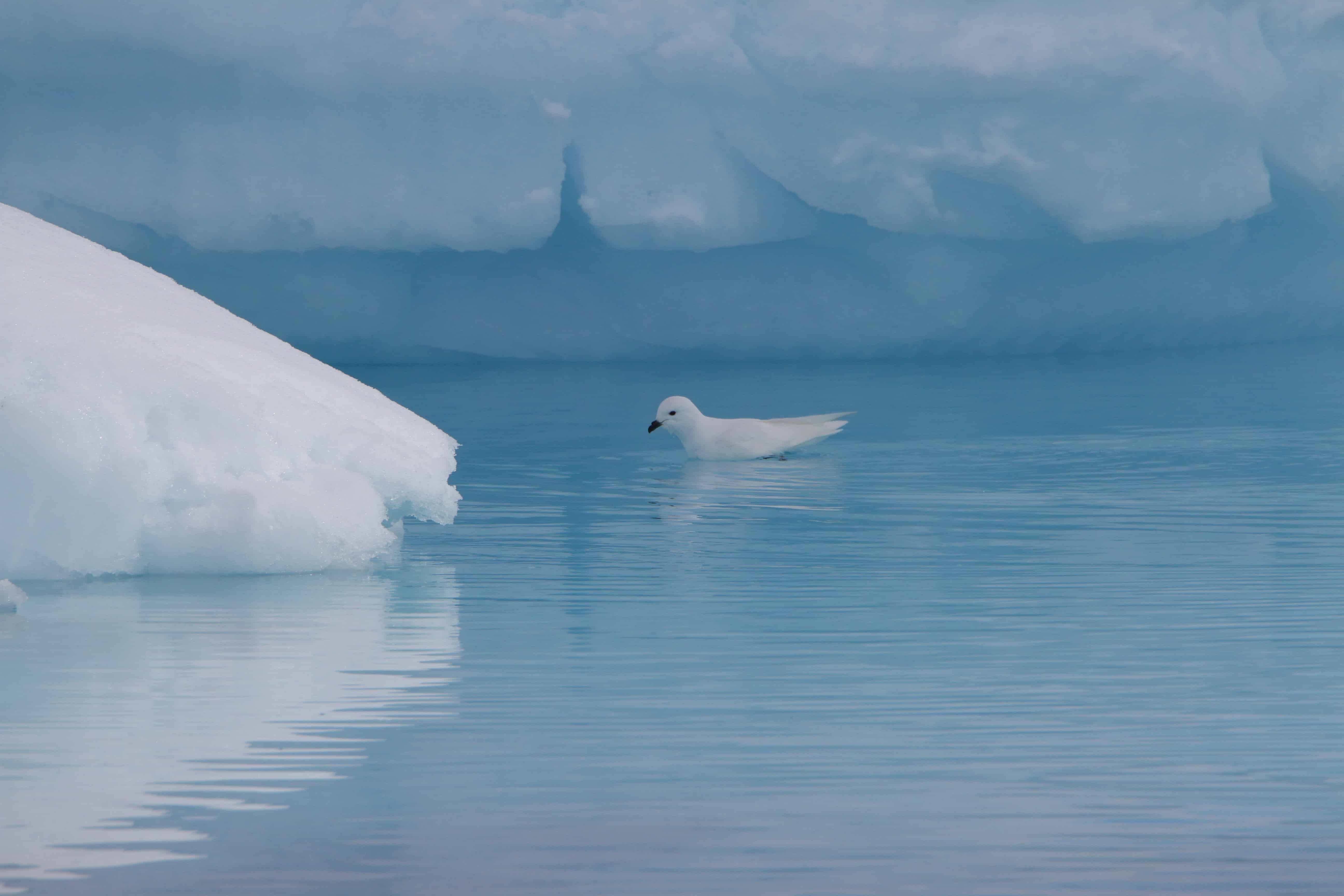
We had nearly 3 days of sailing across the Drake Channel back to Ushuaia, and the Channel lived up to its reputation. In the middle of the journey, there were gusts up to 67 knots with waves up to 12 metres in size. Mike, trying to catch up with some UKOTCF tasks, found that he had to lie on the cabin floor to work, to prevent him and the computer being thrown there. The catering staff coped well with their produce, and sometimes themselves, being tossed to the floor – and the excellent food kept coming.
Despite the two periods of rough seas, we enjoyed great weather for all the key stages, and were looked after very well. This is the second time that we have joined Oceanwide Expeditions, having a few years ago, on the Molchanov, done the end-of-season Atlantic Odysssey: Ushuaia – Antarctic Peninsula – South Georgia – Tristan da Cunha – St Helena – Ascension. Both were superb experiences, and we heartily recommend them. If anyone would like to enquire more about these, do please contact us, initially by email: m@pienkowski.org and apienkowski@clara.co.uk. Remember that, if you decide to undertake one of Oceanwide’s trips and you enquire initially through UKOTCF, conservation work by UKOTCF will benefit financially at no extra cost to yourself. Have a great and unique (all trips are different) experience and bene t conservation at the same time!
